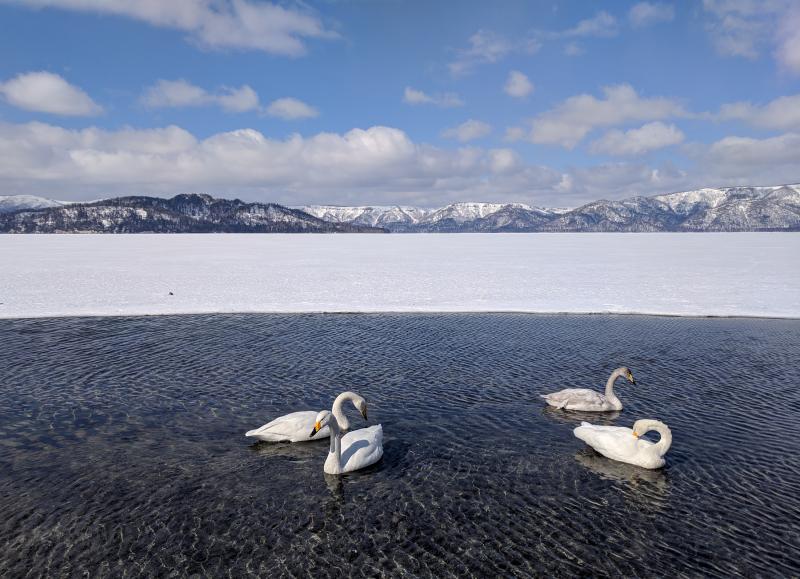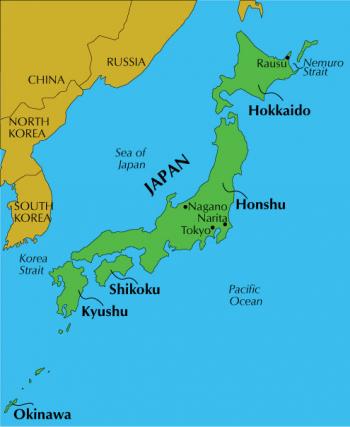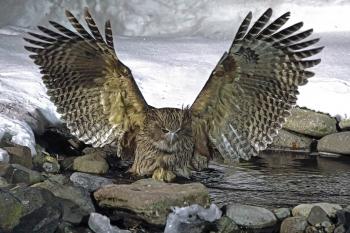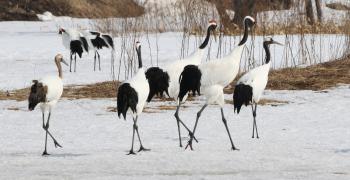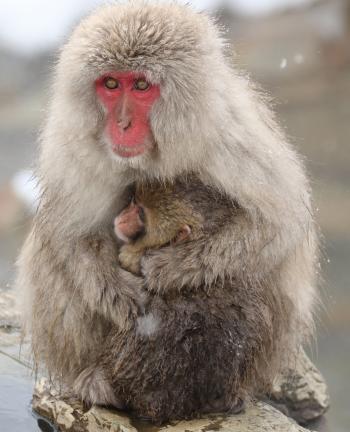Wonderful winter wildlife in Japan
This article appears on page 6 of the October 2021 issue.
Winter is the best time to see some of Japan’s iconic wildlife, including red-crowned cranes, Blakiston’s fish owls and sea eagles in the northernmost island of Hokkaido, and snow monkeys, south of Tokyo, on the island of Honshu. In March 2019, an opportunity to see this wildlife for ourselves came when my wife, Norma, and I signed up for a 7-day tour, “Winter Birding and Bird Photography in Japan,” with Gunnar Engblom, guide and owner of Kolibri Expeditions (Lima, Peru; kolibriexp@gmail.com, kolibriexpeditions.com).
The adventure begins
Our alarm went off at 2:30 a.m., waking us from a sound sleep at the Shiretoko Serai Hotel in Rausu, on the island of Hokkaido. Clothes already set out, we layered up, ready to go owling — looking for not just any owl but for the endangered Blakiston’s fish owl, the world’s largest. It is rare in the forests of Russia and eastern Hokkaido, but we were told it could be reliably seen at the nearby Washi No Yado guest house.
After driving for about 15 minutes, we turned off the main road, tires crunching on the icy driveway that led to the inn.
We had been there earlier the evening before, walking through the dining room to the adjacent bird blind, crowded and cold from all the open observation windows. But after two hours, the owl had not shown itself, so we returned to our hotel for dinner, having been told that the owl often came out late at night.
Returning after 3 a.m., we found the inn quiet and warm, with only one other couple in the blind.
Birding is often a waiting game. After about 30 minutes, a dark shadow materialized in a tree near the stream. The owl dropped to the snow and waddled to an impoundment created in the stream, stocked with the proverbial fish in a barrel. The owl started to pull out fish after fish as we watched, entranced, photographing the owl catching and eating fish. Occasionally it would stop, face in the direction of the windows and flap its majestic wings.
Next on our quest was the rare red-crowned crane, or tancho, a Japanese symbol of longevity and immortality. Winter is the perfect time to observe the resident population in eastern Hokkaido.
The Akan International Crane Center is the largest feeding site in the area, set up to save the cranes’ dwindling population. It usually attracts a large population of cranes, but in March 2019, the center stopped feeding to halt the spread of a bird virus. There were some birds present when we visited, but they were far away.
We had much better luck at its annex, the Tancho Observation Center. Though it covers a smaller area, the 50-plus cranes we found there were closer and easier to see and photograph.
Photographers crowded the wooden-rail fence separating visitors from the feeding area, and the ground leading to the viewing area was icy and slippery.
Cranes were eating, honking, dancing and flying in and out of the sanctuary. It was magnificent watching the mostly all-white cranes with their 8-foot wingspans fly by.
At the nearby Otowa Bridge, cranes could be seen slowly walking in the shallows of the stream below, searching for food.
Searching for sea eagles
Sea eagles migrate south to overwinter in the seas around Hokkaido. From Rausu, a fishing town facing the Nemuro Strait, excursion boats leave to visit the offshore pack ice, where white-tailed eagles (similar to the bald eagle) and Steller’s sea eagles (the heaviest of the eagles and considered, by some, to be the most attractive of the raptors) can be seen.
Our tour boat, the Evergreen, left Rausu on a brilliant, cold afternoon with a clear, blue sky. We sat on the lee side of the boat to escape the cold wind.
Crewmembers started to chum the waters, and, at first, only raucous gulls and crows were diving and fighting for the bait. However, as we got closer to the ice, white-tailed eagles appeared, swooping in to get the fish that was being thrown out.
The larger Steller’s sea eagles were more aloof, remaining perched, their yellow talons gripping the ice, watching but making no attempt to catch any fish.
Our boat got close to the edge of the pack ice, giving us close-up views of the eagles. Farther in, on top of the ice, small groups of eagles gathered. The white-tailed eagles ate and fought over fish while the Steller’s sea eagles sat looking regal, appearing to take it all in.
Time for some monkey business
The Japanese macaque (aka snow monkey) has the northernmost range of any primate and thrives in cold and snow. At Jigokudani Yaen Koen (Snow Monkey Park), one group has learned to use the hot springs to warm up during winter.
Snow monkeys were a “must see” for us on this tour, but we almost missed them! They only go into the hot springs when they are cold, and we were there as the weather was warming up.
The group before us saw them in the snow-covered woods but not bathing in the hot springs. When our guide checked the weather for the day of our visit, the forecast was cold and snowing — perfect snow monkey weather.
To get to Snow Monkey Park, we took the shinkansen (bullet train) from Tokyo to Nagano. Missing our connection to the local bus, we took a taxi to the park.
Driving up to the mountains, we could see snow swirling around the mountaintops that are home to the monkeys. Once there, we had to walk from where the taxi left us off to get to the park entrance, then it was about a mile uphill to get to the hot spring where the monkeys were hanging out. (The total distance from the taxi station to the hot spring and back is about 3 miles.)
The trail alternated from muddy to snowy or icy, in no particular order. Occasionally, the wind blew snow down on us from the trees as we walked along.
At the end of the trail, we passed a bridge leading to an onsen (hot spring) and took a short set of stairs leading to a viewing area, crowded with visitors, above the hot spring ringed by rocks. From there, we watched 15-20 snow monkeys appearing to luxuriate in the warm water, adults grooming each other or holding and grooming the young monkeys.
The younger monkeys congregated along the edge as others continually went in and out of the water. Mist enveloped the monkeys, their expressive red faces surrounded by fur rimmed with moisture.
We started to get cold, so we headed back down the trail, past the park entrance, to a small restaurant, where we enjoyed some shrimp tempura.
Though we traveled to Japan to see some specific animals, our journey also delivered sightings of wildlife that Gunnar called “by-catch.”
Close to where we saw the fishing owl was the day roost of a Ural owl. We turned onto a snow-covered road, parked and walked a short distance through the woods to a viewpoint, where we saw a medium-size owl roosting, eyes closed, on the other side of a stream. Gunnar made the squeaking sound of a mouse, and its eyes popped open just long enough for me to take a photo.
At Lake Kussharo, in Akan-Mashu National Park near the Akan Crane Center, whooper swans swam along the mostly frozen lake’s ice-free edge while others walked on the ice.
We spent the last full day of the tour in Tokyo. From our hotel near Ueno Train Station, we took the train to Hibiya Park. Walking through the park, enjoying the warm spring sun, we kept our eyes out for local birds. After a stop at the Buvette café for lovely pastries and, for me, hot chocolate, we continued on to the moat of the Imperial Palace, a magnet for wading birds.
The cost of our tour was $2,249 per person, including round-trip air from Tokyo’s Narita International Airport to Hokkaido; train travel (using a flexible 5-day JR East Pass); hotels, and about half of our meals. Additional meals and snacks cost $400, and the round-trip flight on Delta from Philadelphia to Narita, via Detroit, cost $1,106 each.
We lost a day of our scheduled tour because of snow in Philadelphia, but we were still able to visit all the sites on the itinerary, and the lost time was covered by insurance.

